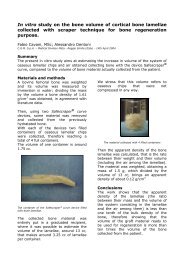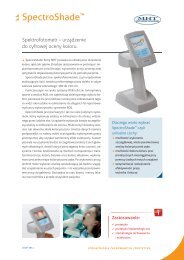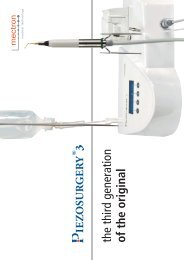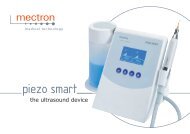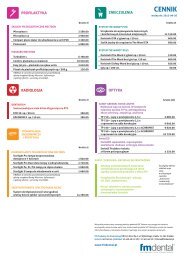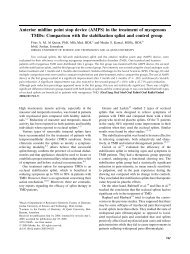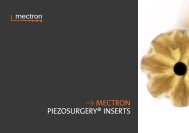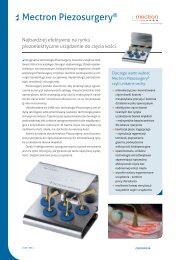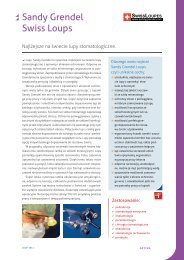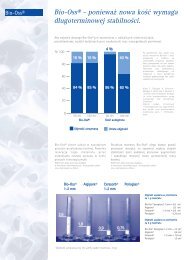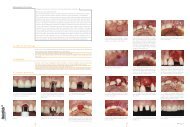POCKET GUIDE TO TECHNIQUES & KNOTS SUTURE MATERIALS
POCKET GUIDE TO TECHNIQUES & KNOTS SUTURE MATERIALS
POCKET GUIDE TO TECHNIQUES & KNOTS SUTURE MATERIALS
Create successful ePaper yourself
Turn your PDF publications into a flip-book with our unique Google optimized e-Paper software.
<strong>POCKET</strong> <strong>GUIDE</strong> <strong>TO</strong><br />
<strong>SUTURE</strong> <strong>MATERIALS</strong><br />
<strong>TECHNIQUES</strong> & <strong>KNOTS</strong><br />
SERAG<br />
WIESSNER
Pocket guide to<br />
suture materials<br />
Suture materials are very closely related<br />
to surgery and have been throughout its<br />
history. Even with the introduction of alternative<br />
methods of wound closure such as<br />
strips and clips, suture materials are still<br />
of paramount importance. It is no exaggeration<br />
to claim that hardly any surgical procedure<br />
is performed without the use of suture<br />
material.<br />
This booklet makes no claim to be an<br />
exhaustive review of the subject. As its title<br />
implies, it is intended as a handy and<br />
uncluttered guide for those working with<br />
surgical suture materials. As such, it has<br />
been deliberately designed to fit into any<br />
pocket.<br />
Our guide to suture material is intended to<br />
provide the basis for a more detailed study<br />
of the subject and we hope that you find it<br />
useful. We are, of course, always grateful for<br />
any comments and suggestions.<br />
Sincerely<br />
Serag-Wiessner KG – Naila, Germany<br />
4 th revised edition<br />
Copyright held by Serag-Wiessner KG, Naila, Germany<br />
No reproduction or reprinting without explicit<br />
authorisation. Errors excepted.<br />
CONTENTS<br />
3
Contents<br />
SERAG-WIESSNER<br />
THE COMPANY<br />
Suture material<br />
The history of suture material<br />
Types of threads<br />
Classification of material<br />
Classification of suture sizes<br />
International labelling symbols<br />
Description of suture material<br />
Needles<br />
Steel quality<br />
Atraumatic needles<br />
Spring eye needles<br />
Recommendations for selection<br />
of suture materials<br />
Explanation of symbols<br />
for medical devices<br />
Suture and knot-tying techniques<br />
Handling<br />
Suture technique<br />
Examples of interrupted sutures<br />
Examples of continuous sutures<br />
Special sutures<br />
Knot-tying techniques<br />
Types of knot<br />
Knotting techniques<br />
1<br />
2<br />
3<br />
4<br />
5<br />
6<br />
8<br />
8<br />
12<br />
12<br />
18<br />
20<br />
24<br />
37<br />
38<br />
39<br />
43<br />
44<br />
48<br />
51<br />
52<br />
54<br />
55<br />
56<br />
57<br />
61<br />
63<br />
65<br />
CONTENTS<br />
5
6<br />
THE COMPANY<br />
SERAG-WIESSNER is the longest established<br />
German manufacturer of surgical<br />
suture materials. In 1866 Carl Wiessner<br />
founded a gut string factory in Berlin.<br />
Industrial production of sterile catgut was<br />
started around 1900. Until that time sterilization<br />
had been carried out exclusively by<br />
hospitals. After 1945 the company moved to<br />
Northern Bavaria. SERAG-WIESSNER came<br />
into being via a merger with SERAG<br />
Catgutfabrik.<br />
Today the company employs more than<br />
200 people at its sole production site at<br />
Naila. In addition to surgical suture materials,<br />
SERAG-WIESSNER produces infusion solutions.<br />
The independence of this mediumsized,<br />
family-owned company has proved<br />
to be a major asset. Customers view<br />
SERAG-WIESSNER as a flexible and reliable<br />
company with short response times<br />
and clearly defined responsibilities.
SERAG WIESSNER<br />
The manufacture of surgical suture materials<br />
is characterized by a combination of<br />
ultra-modern production techniques and a<br />
high proportion of manual work. At SERAG-<br />
WIESSNER, needle-thread combinations<br />
are produced and sterilized in clean rooms<br />
via state-of-the-art, computer-controlled<br />
techniques that comply with the most exacting<br />
international standards. At the same<br />
time, many production steps require the<br />
sensitive and reliable manual input of<br />
employees of many years’ standing. In<br />
order to ensure constant high quality,<br />
SERAG-WIESSNER employs a certified<br />
quality management system that complies<br />
with international standards DIN EN ISO<br />
9001 and DIN EN 46001 and with the<br />
European guideline for medical products.<br />
We implemented an environmental management<br />
system conforming to DIN EN 14001 to<br />
cover all ecological aspects of manufacture.<br />
The materials and manufacturing processes<br />
used are subject to constant external and<br />
internal monitoring. In our control laboratory,<br />
which is equipped with the latest measuring<br />
instruments and analytical tools, comprehensive<br />
checks and tests are performed<br />
exclusively by highly qualified specialist<br />
staff. SERAG-WIESSNER suture materials<br />
always incorporate the latest developments<br />
in research and technology.<br />
For further information about our company,<br />
we will be pleased to send you our corporate<br />
image brochure on request.<br />
THE COMPANY<br />
7
8<br />
The history of suture material<br />
The technique of closing wounds by means of needle and thread<br />
is several thousand years old. The history of surgical sutures can<br />
be traced back to ancient Egypt, and the literature of the classical<br />
period contains a number of descriptions of surgical techniques<br />
involving sutures.<br />
Before catgut became the standard surgical suture material<br />
towards the end of the 19th century, many different paths had<br />
been followed to find a suitable material for sutures and ligatures.<br />
Materials that had been tried included gold, silver and steel wire,<br />
silk, linen, hemp, flax, tree bark, animal and human hair, bowstrings,<br />
and gut strings from sheep and goats.<br />
At the beginning of the 19th century metal threads were tested as<br />
suture material. At that time inertness of a material with respect to<br />
body tissues was considered an advantage. Nevertheless, metal<br />
threads had major disadvantages: their stiffness rendered knottying<br />
more difficult and could easily result in knot breakage; in<br />
addition, suppuration of the wound edges occurred frequently.
These negative experiences with metal contributed to the<br />
establishment of silk as the number one suture material.<br />
Wounds sewn with silk cicatrized within a few days, and the<br />
small knot caused no problems. For these reasons most surgeons<br />
at that time chose silk for sutures and vessel ligatures.<br />
A fundamental change in the assessment of suture materials<br />
followed the publication in 1867 of Lister’s research on the<br />
prevention of wound suppuration. On the basis of work by<br />
Koch and Pasteur, Lister concluded that wound suppuration<br />
could be prevented by disinfecting sutures, dressings, and<br />
instruments with carbolic acid. Initially Lister used silk as a<br />
suture material, on the assumption that it was absorbable and<br />
therefore could also be used for ligatures. Later he searched<br />
for a more rapidly absorbable material and consequently<br />
began to use catgut.<br />
Catgut is produced from animal connective tissue, in particular<br />
bovine subserosa. Over the years it gradually emerged that<br />
animals born and bred in South America were most suitable<br />
because they had the lowest fat content thanks to their natural<br />
husbandry conditions.<br />
The use of catgut was never called into question until the<br />
appearance of BSE at the beginning of the 21st century.<br />
Alternative products had already been developed by this time.<br />
These are the synthetically manufactured absorbable suture<br />
materials which have largely superseded catgut in Europe.<br />
However, catgut continues to play a major role in woundcare<br />
world-wide.<br />
A wide variety of sterilization methods have been tested at<br />
various times. Nowadays sutures are mostly sterilized by<br />
ethylene oxide or gamma irradiation.<br />
In response to the requirements of modern surgery and<br />
thanks to the efforts of users and manufacturers over the last<br />
few decades, a wide variety of sutures have now been developed.<br />
<strong>SUTURE</strong> MATERIAL<br />
9
12<br />
Types of threads<br />
Classification of material<br />
Surgical suture material can be classified on the basis of the characteristics<br />
absorbability, origin of material and thread structure.<br />
This is illustrated by the following diagram.<br />
MONO-<br />
FILAMENT<br />
e.g.<br />
SERASYNTH ®<br />
SERAFAST ®<br />
<strong>SUTURE</strong><br />
<strong>MATERIALS</strong><br />
ABSORBABLE<br />
SYNTHETIC NATURAL<br />
MULTI-<br />
FILAMENT<br />
e.g.<br />
SERAPID ®<br />
SERAFIT ®<br />
MONO-<br />
FILAMENT<br />
MULTI-<br />
FILAMENT<br />
e.g. CATGUT ®<br />
PLAIN and<br />
CHROMIC
MONO-<br />
FILAMENT<br />
e.g.<br />
SERALON ®<br />
SERALENE ®<br />
SERAPREN ®<br />
SERANOX ®<br />
NON-<br />
ABSORBABLE<br />
SYNTHETIC NATURAL<br />
MULTI-<br />
FILAMENT<br />
e.g.<br />
TERYLENE ®<br />
SERACOR ®<br />
SULENE ®<br />
SERANOX ®<br />
MONO-<br />
FILAMENT<br />
MULTI-<br />
FILAMENT<br />
e.g.<br />
SERAFLEX ®<br />
<strong>SUTURE</strong> MATERIAL<br />
1<br />
13
14<br />
Absorbability<br />
An important differentiating characteristic of<br />
suture material is its absorbability in human<br />
tissue. Suture material can be classified as<br />
absorbable or nonabsorbable.<br />
Absorption can occur enzymatically, as with<br />
catgut, or hydrolytically, as with the absorbable<br />
synthetic polymers. An important measure<br />
of absorbability is the absorption time or halflife,<br />
which is defined as the time required for<br />
the tensile strength of a material to be reduced<br />
to half its original value. Dissolution time<br />
is the time that elapses before a thread is<br />
completely dissolved. These times are influenced<br />
by a large number of factors including<br />
thread thickness, type of tissue, and, not<br />
least, the general condition of the patient.<br />
The most important absorption and dissolution<br />
times are shown in the following table:<br />
Approximate absorption times<br />
of synthetic suture materials<br />
Material Half-life Dissolution<br />
(days) time (days)<br />
Serapid ® 6 - 8 30 - 42<br />
Serafit ® 15 - 20 60 - 90<br />
Serasynth ® 28 - 42 180 - 210
Origin of material<br />
Suture materials can be classified as<br />
being of natural or synthetic origin. The<br />
former include silk and catgut. The other<br />
main group of suture materials are those<br />
produced from synthetic polymers such<br />
as polyamide, polyolefines and polyesters.<br />
This group also includes absorbable<br />
polymers derived from polyglycolic<br />
acid. <strong>SUTURE</strong> MATERIAL<br />
Absorption<br />
absorbable sutures<br />
Tensile strength ( %)<br />
100<br />
50<br />
0<br />
x y Days<br />
x = half-value<br />
Period in which a 50 % loss of<br />
tensile strength occurs.<br />
y = dissolution time<br />
Period in which the suture totally<br />
dissolves.<br />
15
16<br />
monofilament<br />
multifilament with coating<br />
Thread structure<br />
Monofilament and multifilament thread<br />
structures are distinguished.<br />
Monofilament threads<br />
Synthetic monofilament threads are produced<br />
by a special extrusion process in<br />
which molten plastic is extruded under<br />
high pressure through fine spinnerets. The<br />
monofilament structure is used mostly for<br />
thinner threads. With thicker threads the<br />
wiriness that is a characteristic of all monofilament<br />
threads impairs handling and<br />
in particular renders knot-tying more difficult.<br />
Because of their smooth, closed surface<br />
and completely closed interior, monofilament<br />
threads have no capillarity. On<br />
the other hand, the ease with which they<br />
pass through tissue is unsurpassed.
multifilament, braided<br />
multifilament, braided and<br />
coated<br />
multifilament, twisted<br />
Multifilament threads<br />
Multifilament threads are composed of<br />
many fine individual threads either twisted<br />
or braided together. The direction<br />
of the twist is generally right-handed.<br />
Twisted multifilament threads include<br />
e.g. silk threads. All twisted threads<br />
show considerable variation in diameter.<br />
Their surface is mostly rough. The<br />
longitudinal orientation of the individual<br />
filaments within the thread results in<br />
relatively high capillarity. In braided<br />
threads the individual filaments lie<br />
more or less obliquely to the longitudinal<br />
axis of the thread. This tends to<br />
impede the passage of fluid. The capillarity<br />
of braided threads is therefore<br />
less than that of twisted threads.<br />
Multifilament threads have a rough surface<br />
that impairs passage through tissue<br />
but results in considerably better<br />
knotholding security. Multifilament<br />
threads are generally coated. The coating<br />
smoothes out the irregular surface<br />
and thus facilitates passage through<br />
tissue without impairing knot-holding<br />
security. Coated multifilament threads<br />
are less stiff and wiry than monofilament<br />
threads. The coating also reduces<br />
capillarity.<br />
<strong>SUTURE</strong> MATERIAL<br />
17
18<br />
Classification of suture material<br />
Size table<br />
Non-absorbable sutures and absorbable synthetic multifilaments<br />
EP (metric) USP Ø in mm<br />
0,01<br />
0,05<br />
0,1<br />
0,2<br />
0,3<br />
0,4<br />
0,5<br />
0,7<br />
1<br />
1,5<br />
2<br />
2,5<br />
3<br />
3,5<br />
4<br />
5<br />
6<br />
7<br />
8<br />
9<br />
10<br />
–<br />
–<br />
12-0<br />
–<br />
11-0<br />
10-0<br />
9-0<br />
8-0<br />
7-0<br />
6-0<br />
5-0<br />
4-0<br />
3-0<br />
–<br />
2-0<br />
0<br />
1<br />
2<br />
3+4<br />
5<br />
6<br />
7<br />
8<br />
9<br />
10<br />
0,001–0,004<br />
0,005–0,009<br />
0,010–0,019<br />
0,020–0,029<br />
0,030–0,039<br />
0,040–0,049<br />
0,050–0,069<br />
0,070–0,099<br />
0,100–0,149<br />
0,150–0,199<br />
0,200–0,249<br />
0,250–0,299<br />
0,300–0,349<br />
0,350–0,399<br />
0,400–0,499<br />
0,500–0,599<br />
0,600–0,699<br />
0,700–0,799<br />
0,800–0,899<br />
0,900–0,999<br />
1,000–1,099<br />
1,100–1,199<br />
1,200–1,299<br />
The tensile strength and knot-tying properties of a surgical suture<br />
material are determined not only by the starting material and<br />
structure, but also by the thickness of the thread. Classification of<br />
thread size must therefore be precise. Within the purview of the<br />
European Pharmacopoeia (EP), suture size is classified according<br />
to a decimal system. This denotes the diameter of the suture<br />
as a multiple of 0.1 mm.
Classification of suture material<br />
Size table<br />
Absorbable synthetic monofilaments<br />
EP (metric) USP<br />
EP (metric) Ø in mm USP Ø in mm<br />
–<br />
–<br />
–<br />
–<br />
–<br />
–<br />
0,5<br />
0,7<br />
1<br />
1,5<br />
2<br />
3<br />
3,5<br />
4<br />
5<br />
–<br />
–<br />
–<br />
–<br />
–<br />
–<br />
–<br />
0,050–0,094<br />
0,095–0,149<br />
0,150–0,199<br />
0,200–0,249<br />
0,250–0,339<br />
0,340–0,399<br />
0,400–0,499<br />
0,500–0,570<br />
0,571–0,610<br />
–<br />
12-0<br />
11-0<br />
10-0<br />
9-0<br />
8-0<br />
7-0<br />
6-0<br />
5-0<br />
4-0<br />
3-0<br />
2-0<br />
Unlike the earlier DAB 6 and USP codes, the new metric code is<br />
directly related to the actual diameter of the suture (e.g. EP 3 =<br />
3 x 0.1 mm = 0.3 mm). As the USP system is still commonly used,<br />
it is shown in the above table for comparison.<br />
0<br />
1<br />
2<br />
3+4<br />
5<br />
0,001–0,009<br />
0,010–0,019<br />
0,020–0,029<br />
0,030–0,039<br />
0,040–0,049<br />
0,050–0,069<br />
0,070–0,099<br />
0,100–0,149<br />
0,150–0,199<br />
0,200–0,249<br />
0,300–0,339<br />
0,350–0,399<br />
0,400–0,499<br />
0,500–0,599<br />
0,600–0,699<br />
0,700–0,799<br />
<strong>SUTURE</strong> MATERIAL<br />
19
20<br />
INTERNATIONAL LABELLING SYMBOLS<br />
The European suture material manufacturers worked together to<br />
harmonise the symbols given below, which habe appeared on<br />
labels and suture holders since 2004:<br />
Absorbable suture material<br />
Ra Surgical suture, absorbable, braided, coated, dyed<br />
e.g. SERAFIT violet<br />
h Surgical suture, absorbable, monofilament, dyed<br />
e.g. SERASYNTH<br />
A Surgical suture, absorbable, braided coated, undyed<br />
e.g. SERAFIT undyed, SERAPID undyed<br />
H Surgical suture, absorbable, monofilament, undyed<br />
e.g. SERAFAST<br />
Non-absorbable suture material<br />
s Surgical suture, non-absorbable, braided,<br />
coated, dyed<br />
e.g. TERYLENE green, SULENE green,<br />
SERACOR green, SERAFLEX black<br />
d Surgical suture, non-absorbable, braided, dyed<br />
f Surgical suture, non-absorbable, twisted, coated, dyed<br />
e.g. SUPRAMID black (USP 4/0 and stronger)<br />
g Surgical suture, non-absorbable, twisted, dyed<br />
e.g. SERAFLEX blue
j Surgical suture, non-absorbable,<br />
monofilament, dyed<br />
e.g. SERAPREN blue, SERALENE blue,<br />
SERALON blue, NYLON black, SUPRAMID black<br />
(USP 5/0 and finer)<br />
k Surgical suture, non-absorbable, monofilament,<br />
coated, dyed<br />
S Surgical suture, non-absorbable, braided,<br />
coated, undyed<br />
e.g. TERYLENE undyed, SERACOR undyed,<br />
SERAFLEX undyed<br />
D Surgical suture, non-absorbable, braided, undyed<br />
e.g. POLYESTER TAPE undyed<br />
F Surgical suture, non-absorbable, twisted,<br />
coated, undyed<br />
e.g. SUPRAMID undyed (USP 4/0 and stronger),<br />
SERANOX multifilament<br />
G Surgical suture, non-absorbable, twisted, undyed<br />
e.g. SERANOX multifilament<br />
J Surgical suture, non-absorbable, monofilament,<br />
undyed<br />
e.g. SERALON undyed, SERANOX monofilament,<br />
SUPRAMID undyed (USP 5/0 and finer)<br />
Needles<br />
y Anti-reflective needle<br />
x Detachable needle<br />
<strong>SUTURE</strong> MATERIAL<br />
21
22<br />
Basic material of the thread<br />
v Polyamide<br />
b Polydioxanone<br />
Rn Polyester<br />
Rr Polyglycolic acid-caprolactone<br />
m Polyglycolic acid<br />
R, Polypropylene<br />
c Polyvinylidene Fluoride<br />
. Silk<br />
- Steel<br />
Further symbols on page 48<br />
Needle abbreviations are explained on page 39
24<br />
SERAFIT ® / SERAFIT S ®<br />
Material m Polyglycolic acid<br />
Symbol a VIOLET<br />
MULTIFILAMENT (braided)<br />
COATED<br />
or<br />
A UNDYED<br />
MULTIFILAMENT (braided)<br />
COATED<br />
Size USP 8/0 to 5 (undyed 6/0 to 2)<br />
EP 0,4 to 7 (undyed 0,7 to 5)<br />
Absorption profile 50% tensile strength after ∼ 18 days<br />
0% after 60–90 days<br />
Available combinations<br />
Unneedled Single sutures / multipacks /<br />
cassette packs<br />
Needled DR, DRN, DS, DSL, DSS, FRX,<br />
GR, GS, HR, HRT, HRX, HS<br />
Single sutures / multipacks<br />
Large range of special<br />
MIS combinations<br />
Advantages · good knot stability<br />
· outstanding suppleness<br />
· minimal saw effect<br />
Uses Ligatures / dermatology /<br />
gastroenterology / gynaecology /<br />
MIS / oral and maxillofacial surgery /<br />
ophthalmology / urology /<br />
veterinary medicine
SERAPID ®<br />
Material m Polyglycolic acid<br />
Symbol A UNDYED<br />
MULTIFILAMENT (braided)<br />
COATED<br />
Size USP 6/0 to 2<br />
EP 0,7 to 5<br />
Absorption profile 50% tensile strength after 5–7 days<br />
0% after 42 days<br />
Available combinations<br />
Unneedled Multipacks<br />
Needled DR / DS / DSS / FRX / GR / GS /<br />
HR / HRN / HRT / HRX / HS / KS<br />
Single sutures / multipacks<br />
Advantages · high knot-pull tensile strength<br />
· easy knot gliding<br />
· optimal tissue passage<br />
Uses ENT / gynaecology /<br />
paediatric surgery /<br />
oral and maxillofacial surgery /<br />
plastic surgery / urology<br />
<strong>SUTURE</strong> MATERIAL<br />
25
26<br />
SERAFAST ®<br />
Material r Polyglycolic acidcaprolactone<br />
Symbol H UNDYED<br />
MONOFILAMENT<br />
Size USP 5/0 to 2/0<br />
EP 1 to 3<br />
Absorption profile 50% tensile strength after 8–13 days<br />
0% after 90–120 days<br />
Available combinations<br />
Unneedled Multipacks<br />
Needled DS / DSS / HR<br />
Single sutures<br />
Advantages · unsurpassed handling<br />
· outstanding tissue sliding ability<br />
· optimal absorption profile<br />
Uses Ligatures / dermatology /<br />
plastic surgery / urology /<br />
gynaecology / skin closure
SERASYNTH ®<br />
Material b Polydioxanone<br />
Symbol H UNDYED<br />
MONOFILAMENT<br />
or<br />
h VIOLET<br />
MONOFILAMENT<br />
Size USP 7/0 to 2 (undyed 6/0 to 2/0)<br />
EP 0,5 to 5 (undyed 0,7 to 3)<br />
Absorption profile 50% tensile strength after 28–42 days<br />
0% after 180–210 days<br />
Available combinations<br />
Unneedled Single sutures / multipacks<br />
Needled DR / DS / DSS / GR / GS / HR /<br />
HRT / HRX / HS<br />
Single sutures / multipacks<br />
Advantages · outstanding sliding ability<br />
· high linear and knot-pull<br />
· tensile strength<br />
· very supple handling<br />
· reliable absorption behaviour<br />
Uses Ligatures / dermatology /<br />
vascular surgery / orthopaedics /<br />
plastic surgery / urology<br />
<strong>SUTURE</strong> MATERIAL<br />
27
28<br />
SERALON ® / NYLON<br />
Material v Polyamid<br />
Symbol j BLUE (SERALON ® )<br />
BLACK (NYLON)<br />
MONOFILAMENT<br />
or<br />
J UNDYED (SERALON ® )<br />
MONOFILAMENT<br />
Size SERALON ® : USP 7/0 to 3+4<br />
EP 0,5 to 6<br />
NYLON: USP 11/0 to 8/0<br />
EP 0,1 to 0,4<br />
Absorption profile non-absorbable<br />
Available combinations<br />
Unneedled Single sutures / multipacks /<br />
cassette packs<br />
Needled DR / DRT / DS / DSS / DSX /<br />
GR/GS/HR/ HRT/HRX/HS/<br />
KS / VSP<br />
Single sutures / multipacks<br />
Advantages · best skin suture material<br />
· outstanding sliding ability<br />
· very high linear and knot-pull<br />
tensile strength with finde thread<br />
· very pleasant handling<br />
· economical large packs<br />
Uses Ligatures / general surgery /<br />
orthopaedics / plastic surgery
SUPRAMID<br />
Material v Polyamide<br />
Symbol f BLACK<br />
MULTIFILAMENT (twisted)<br />
COATED<br />
or<br />
F UNDYED<br />
MULTIFILAMENT (twisted)<br />
COATED<br />
USP 5/0 and finer:<br />
J or j<br />
Size USP 6/0 to 6 (undyed 5/0 to 6)<br />
EP 0,7 to 8 (undyed 0,5 to 8)<br />
Absorption profile non-absorbable<br />
Available combinations<br />
Unneedled Single sutures multipacks /<br />
cassette packs<br />
Needled DR / DS / DSF / DSS / FRX /<br />
GR / HR / HRT / HS / VSP<br />
Single sutures / multipacks<br />
Advantages · excellent knot stability<br />
· outstanding sliding ability<br />
· high linear and knot-pull<br />
· tensile strength<br />
· economical large packs<br />
Uses Ligatures / general surgery /<br />
oral and maxillofacial surgery /<br />
skin closure<br />
<strong>SUTURE</strong> MATERIAL<br />
29
30<br />
TERYLENE<br />
Material n Polyester<br />
Symbol s GREEN<br />
MULTIFILAMENT (braided)<br />
COATED<br />
or<br />
S UNDYED<br />
MULTIFILAMENT (braided)<br />
COATED<br />
Size USP 7/0 to 5 (undyed 6/0 to 6)<br />
EP 0,5 to 7 (undyed 0,7 to 7)<br />
Absorption profile non-absorbable<br />
Available combinations<br />
Unneedled Single sutures / multipacks /<br />
cassette packs<br />
Needled DR / DRT / DS / DSS / FRX /<br />
GR / GS / HR / HRN / HRT / HRX /<br />
HS/KS/LR/VSP<br />
Single sutures / multipacks<br />
Advantages · universal suture material<br />
· outstanding sliding ability<br />
· very high linear and knot-pull<br />
tensile strength<br />
· very pleasant handling<br />
· economical large packs<br />
Uses Ligatures / holding sutures /<br />
marking / universal use
SULENE ®<br />
Material n Polyester<br />
Symbol f GREEN<br />
MULTIFILAMENT (braided)<br />
COATED<br />
Size USP 6/0 to 5<br />
EP 0,7 to 7<br />
Absorption profile non-absorbable<br />
Available combinations<br />
Unneedled Single sutures / multipacks /<br />
cassette packs<br />
Needled DR / DS / DSS / FRX / GR /<br />
HR / HRT / HRX / HS / KS<br />
Single sutures / multipacks<br />
Advantages · universal suture material<br />
· optimal sliding ability<br />
· very high linear and knot-pull<br />
tensile strength<br />
· economical large packs<br />
Uses Ligatures / holding sutures /<br />
marking / MIS / universal use<br />
<strong>SUTURE</strong> MATERIAL<br />
31
32<br />
SERACOR ®<br />
Material n Polyester<br />
Symbol s GREEN<br />
MULTIFILAMENT (braided)<br />
COATED<br />
or<br />
S UNDYED<br />
MULTIFILAMENT (braided)<br />
COATED<br />
Size USP 6/0 to 1 (undyed 6/0 to 0)<br />
EP 0,7 to 4 (undyed 0,7 to 3,5)<br />
Absorption profile non-absorbable<br />
Available combinations<br />
Needled DRT / HR / HRT<br />
Single sutures / multipacks<br />
with and without pledgets<br />
Advantages · special suture material for<br />
cardiac surgery<br />
· oval pledgets for simple,<br />
secure placement<br />
· outstanding tissue tolerability<br />
Uses Cardiac surgery<br />
Special heart valve sutures,<br />
also for paediatric cardidac surgery<br />
with small pledgets
SERAPREN ®<br />
Material , Polypropylene<br />
Symbol j BLUE<br />
MONOFILAMENT<br />
Size USP 10/0 to 1<br />
EP 0,2 to 4<br />
Absorption profile non-absorbable<br />
Available combinations<br />
Needled DR / DRM / DRT / DS / DSL /<br />
DSS / HR / HRT / HRX / HSL / VSP<br />
Single sutures / multipacks /<br />
long pack / intracutaneous sutures<br />
Advantages · best results for skin<br />
wound closure<br />
· very high tensile strength<br />
· high knot stability<br />
· outstanding tissue tolerability<br />
· long pack minimises<br />
memory effect<br />
Uses Ligatures / vascular surgery /<br />
microsurgery / orthopaedics /<br />
plastic surgery<br />
<strong>SUTURE</strong> MATERIAL<br />
33
34<br />
SERALENE ®<br />
Material c Polyvinylidene Fluoride<br />
Symbol j BLUE<br />
MONOFILAMENT<br />
Size USP 10/0 to 1<br />
EP 0,2 to 4<br />
Absorption profile non-absorbable<br />
Available combinations<br />
Needled DR / DRM / DRT / DS / DSS /<br />
FRX / GR / GS / HR / HRT / HRX /<br />
HS / KS / LR<br />
Single sutures / multipacks<br />
Award-winning long pack<br />
Advantages · sustained tensile strength<br />
· high knot stability<br />
· scarcely any memory effect<br />
after stretching<br />
· best results in vascular surgery<br />
Uses Ligatures / vascular surgery /<br />
microsurgery / plastic surgery
SERAFLEX ®<br />
Material . Silk<br />
Symbol s BLACK<br />
(until size USP 7/0)<br />
MULTIFILAMENT (braided)<br />
COATED<br />
or<br />
S UNDYED<br />
MULTIFILAMENT (braided)<br />
COATED<br />
or<br />
g BLUE<br />
(from size USP 8/0 on)<br />
MULTIFILAMENT (twisted)<br />
Size USP 8/0 to 5<br />
EP 0,4 to 7<br />
Absorption profile non-absorbable<br />
Available combinations<br />
Unneedled Single sutures / multipacks /<br />
cassette packs<br />
Needled DR / DRT / DS / DSL / DSS /<br />
DSX / GR / GS / HR / HRT / HRX /<br />
HS / HSM / KS / VSP<br />
Single sutures / multipacks<br />
Advantages · high knot stability<br />
· outstanding sliding ability<br />
· very pleasant handling<br />
· economical large packs<br />
Uses Ligatures / holding sutures /<br />
marking / oral and maxillofacial<br />
surgery / ophthalmology<br />
<strong>SUTURE</strong> MATERIAL<br />
35
36<br />
SERANOX ®<br />
Material - STEEL<br />
Symbol G MULTIFILAMENT (twisted)<br />
or<br />
F MULTIFILAMENT (twisted)<br />
COATED<br />
J MONOFILAMENT<br />
Size USP 5/0 to 8<br />
EP 1 to 10<br />
Absorption profile non-absorbable<br />
Available combinations<br />
Unneedled Single sutures / multipacks<br />
Needled DS / GR / GS / HRK / HRT / HS<br />
Single sutures / multipacks /<br />
long packs<br />
Special combinations for trauma<br />
surgery and cardiac surgery<br />
Advantages · highest tensile strength<br />
· various accessories available<br />
· with special needles for sternal<br />
closure<br />
Uses Cardiac surgery (sternum) /<br />
orthopaedics / trauma surgery
38<br />
Steel quality for needles<br />
Today it can be assumed that, at least with respect to European<br />
manufacturers, stainless steel (i.e. non-rusting steel) needles are<br />
generally used for surgical suture materials.<br />
The following groups of stainless steel are used for the needles:<br />
· 420 steel: standard quality steel, martensitic, low ductility,<br />
low bending strength<br />
· 455 steel: better 400 quality steel, martensitic, higher ductility,<br />
higher bending strength<br />
· 300 steel: best quality steel, austenitic, highest ductility,<br />
highest bending strength, frequently offered<br />
exclusively for cardiovascular surgery;<br />
used by SERAG-WIESSNER for nearly all suture<br />
materials.<br />
Reference values for comparison<br />
Type of<br />
needle<br />
HR-22<br />
HR-26<br />
HR-36<br />
Steel<br />
quality<br />
420<br />
455<br />
300<br />
420<br />
455<br />
300<br />
420<br />
455<br />
300<br />
Ductility<br />
[illegible]<br />
90<br />
300<br />
700<br />
80<br />
400<br />
500<br />
100<br />
400<br />
700<br />
Ductility<br />
[number<br />
of 180°<br />
movements]<br />
Comments:<br />
· The penetration force of a needle depends in the first line on<br />
its shape and the polished and etched microsection of the tip,<br />
and less on the quality of the steel<br />
· Ductility: how often a needle can be bent back and forth before<br />
it breaks<br />
· Austenite: microstructure of steel. Austenitic microstructure is<br />
face-centred cubic, forms at high temperatures above approx.<br />
1300°C and only remains stable at these temperatures. The<br />
addition of alloy components such as nickel and manganese,<br />
however, maintains this structure at room temperature.<br />
· Martensite: microstructure of steel. Martensitic microstructure<br />
forms at high temperatures. It is extremely hard and the structure<br />
can be maintained by rapid cooling (“quenching”).<br />
0<br />
2<br />
4<br />
0<br />
2<br />
3<br />
0<br />
2<br />
4<br />
Bending<br />
strength<br />
[N]<br />
3.6<br />
3.6<br />
6.4<br />
4.3<br />
5.0<br />
6.0<br />
5.3<br />
5.9<br />
6.6
Needles<br />
In addition to the thread, the needle is an essential component<br />
of sutures. In the classical procedure, a non-needled suture is<br />
fitted with a spring eye or regular eye surgical needle by the<br />
user only at the time of use. Nowadays, atraumatic sutures are<br />
widely used.<br />
Atraumatic Needles<br />
Atraumatic sutures are defined as needle-suture combinations,<br />
where the needle is firmly attached to the suture in order<br />
to reduce tissue trauma. Combined with our suture threads our<br />
customers are offered a wide choice of atraumatic needles.<br />
These stainless steel needles of high bending resistance and<br />
outstanding penetration capacity permit a safe and easy work.<br />
The designations of our atraumatic needles consist of a letternumber<br />
combination as per suggestion of the Technical<br />
Commitee of the Association of Manufacturers of Surgical<br />
Sutures. The first letter indicates the needle shape, the second<br />
letter indicates the needle type. If a third or fourth letter follows,<br />
these refer to special characteristics of the needle. The<br />
number after the letters indicates the overall length of the<br />
needle in mm.<br />
Needle shape<br />
A = fish-hook-shaped<br />
D = 3 /8 circle<br />
F = 5 /8 circle<br />
G = straight<br />
H = 1 /2 circle<br />
K = semi-curved<br />
L = spoon-shaped<br />
V = 1 /4 circle<br />
Needle type<br />
R = round-bodied<br />
S = reverse cutting<br />
Special characteristics<br />
A = asymptotic<br />
F = slim needle<br />
L = lancet point<br />
M = micro point<br />
N = blunt, round-bodied<br />
S = slim<br />
SP = spatula needle<br />
T = trocar needle<br />
X = extra strong<br />
K = short inlying blade<br />
Examples<br />
DSS 15 D 3<br />
/8 circle<br />
S reverse cutting<br />
S slim<br />
15 15 mm long<br />
(straigthened<br />
length)<br />
DS 18 D 3<br />
/8 circle<br />
S reverse cutting<br />
18 18 mm long<br />
(straigthened<br />
length)<br />
HRX 22 H 1<br />
/2 circle<br />
R round-bodied<br />
X extra strong<br />
22 22 mm long<br />
(straightened<br />
length)<br />
needle point<br />
curve length<br />
= straightened length<br />
attaching zone<br />
needle<br />
diameter<br />
needle body<br />
<strong>SUTURE</strong> MATERIAL<br />
2<br />
39
40<br />
NEEDLE OVERVIEW Atraumatic needles<br />
DR<br />
DRM<br />
DRT<br />
DS<br />
DSL<br />
DSLA<br />
DSMF<br />
DSS<br />
FRN<br />
FRX<br />
GR<br />
GS<br />
3<br />
/8 circle, round-bodied needle,<br />
e.g. DR-25<br />
3 /8 circle, round-bodied needle with<br />
micro-point, e.g. DRM-6<br />
3 /8 circle, round-bodied needle with<br />
trocar point, (trocar needle),<br />
e.g. DRT-26<br />
3<br />
/8 circle, reverse cutting needle,<br />
e.g. DS-25<br />
3 /8 circle, cutting needle with lancet<br />
point, e.g. DSL-6<br />
3 /8 circle, cutting needle with lancet<br />
point, asymptotic, e.g. DSLA-4<br />
3 /8 circle needle with micro-point<br />
fine needle, e.g. DSMF-18<br />
3 /8 circle, reverse cutting needle,<br />
special point, slim, e.g. DSS-24<br />
5<br />
/8 circle, round-bodied, blunt,<br />
e.g. FRN-27<br />
5 /8 circle, round-bodied needle (extra<br />
strong needle), e.g. FRX-27<br />
straight, round-bodied needle,<br />
e.g. GR-20<br />
straight, reverse cutting needle,<br />
e.g. GS-20
HR<br />
HRK<br />
HRT<br />
HRX<br />
HS<br />
HSL<br />
HSM<br />
HSP<br />
HSX<br />
KS<br />
LR<br />
VSP<br />
1<br />
/2 circle, round-bodied needle,<br />
e.g. HR-26<br />
1<br />
/2 circle, round-bodied needle,<br />
short inlying blade,<br />
e.g. HRK-48<br />
1 /2 circle, round-bodied needle with<br />
trocar point (trocar needle),<br />
e.g. HRT-26<br />
1 /2 circle, round-bodied needle<br />
(extra strong needle), e.g. HRX-25<br />
1<br />
/2 circle, reverse cutting needle,<br />
e.g. HS-25<br />
1 /2 circle, cutting needle with lancet<br />
point, e.g. HSL-5<br />
1 /2 circle, cutting needle with micro<br />
point, e.g. HSM-8<br />
1 /2 circle, spatula needle,<br />
e.g. HSP-9<br />
1 /2 circle, reverse cutting needle<br />
(extra strong needle),<br />
e.g. HSX-25<br />
semicurved, reverse cutting needle,<br />
e.g. KS-22<br />
spoon-shaped, round-bodied<br />
needle, e.g. LR-25<br />
1 /4 circle, spatula needle,<br />
e.g. VSP-8<br />
without picture DRX, DSF, DSX, HRM<br />
<strong>SUTURE</strong> MATERIAL<br />
41
42<br />
round-bodied<br />
needle<br />
round-bodied<br />
needle with trocar<br />
point<br />
reverse cutting<br />
needle<br />
reverse cutting<br />
needle, special<br />
point, slim
Spring eye surgical needles<br />
Spring eye surgical needles are made of 300-series stainless<br />
steel. This generation of needles is characterised by optimum<br />
resistance to bending, the best possible ductility and outstanding<br />
tissue penetration. This guarantees safe and simple working<br />
conditions.<br />
Like our atraumatic needles, our spring eye needles are designated<br />
by a letter-number combination. The needle codes<br />
thus correspond to those of the atraumatic needles.<br />
Spring eye<br />
<strong>SUTURE</strong> MATERIAL<br />
43
44<br />
Recommendations<br />
for the selection of suture material<br />
Only recommendations<br />
Field of Surgery<br />
General<br />
surgery<br />
Gastroenterology<br />
Cardiac surgery<br />
Vascular surgery<br />
Plastic surgery<br />
Microsurgery<br />
Organ/Tissue Suture Material/<br />
Product<br />
skin<br />
vessel ligation<br />
ligature<br />
fascia<br />
closure of<br />
abdominal wall<br />
hernia repair<br />
stomach and<br />
small intestine<br />
large intestine<br />
biliary ducts<br />
peritoneum<br />
heart valves<br />
coronary arteries<br />
blood vessels<br />
skin<br />
blood vessels<br />
nerves<br />
Seralon ® , Serapren ® ,<br />
Seralene, Supramid<br />
Serafast<br />
Serafit ®<br />
Serafit ®<br />
Serasynth<br />
Serafit ®<br />
Serasynth<br />
Serapren ® , Seralene<br />
Seramesh<br />
Serafit ®<br />
Serafit ®<br />
Serafit ®<br />
Serafit ®<br />
Seracor ®<br />
Serapren ®<br />
Seralene ®<br />
Serapren ® , Seralene<br />
Seralon ® , Serapren ® ,<br />
Seralene, Serafit ®,<br />
Serapid ® , Serafast<br />
Nylon, Serapren ® ,<br />
Seralene ®<br />
Serapren ® , Seralene ®
EP<br />
1-3<br />
1-3<br />
1,5-3,5<br />
3-3,5<br />
1,5-3<br />
1,5-2<br />
1,5-3<br />
1-2<br />
1,5-3<br />
0,5-1<br />
0,5-2<br />
0,7-1<br />
0,1-0,4<br />
0,3-1,5<br />
Size Needles<br />
USP<br />
5/0-2/0<br />
5/0-2/0<br />
4/0-0<br />
2/0-0<br />
4/0-2/0<br />
4/0-3/0<br />
4/0-2/0<br />
5/0-3/0<br />
4/0-2/0<br />
7/0-5/0<br />
7/0-3/0<br />
6/0-5/0<br />
11/0-8/0<br />
9/0-4/0<br />
DSS, DS<br />
non-needled<br />
HS, HR, HRX<br />
HR<br />
2-3 3/0-2/0 HR<br />
HR, DR<br />
HR<br />
HR<br />
HR<br />
HR, HRT<br />
DR<br />
DR, DRM<br />
DRT, HR, HRT<br />
DSS<br />
DR, DRM<br />
DR<br />
<strong>SUTURE</strong> MATERIAL<br />
45<br />
3
46<br />
Field of Surgery<br />
Ophthalmology<br />
Dental surgery<br />
Urology<br />
Gynaecology<br />
Organ/Tissue<br />
kidneys<br />
urinary tracts<br />
phimoses<br />
vagina<br />
Thoracic surgery lungs<br />
thorax closure<br />
Orthopaedics tendons<br />
ligaments<br />
semilunar<br />
cartilage<br />
bone<br />
Suture Material/<br />
Product<br />
Nylon<br />
Seraflex, Serafit ® ,<br />
Serapid ® , Sulene<br />
Serafit ®<br />
Serasynth ®<br />
Serasynth ®<br />
Serafit ®<br />
Serapid ®<br />
Serafit ® , Serapid ®<br />
Serafit ®<br />
Seranox<br />
Serasynth ®<br />
Serasynth ®<br />
Seranox<br />
Serapren ®<br />
Seralon ®<br />
Serasynth ®<br />
Serasynth ®<br />
Seranox<br />
Serasynth ®<br />
Bone Wax
Size<br />
EP USP<br />
0,2-0,4<br />
1,5-3<br />
2-3,5<br />
1,5-2<br />
1-2<br />
3-4<br />
10/0-8/0<br />
4/0-2/0<br />
4/0-2/0<br />
4/0-3/0<br />
5/0-3/0<br />
Needles<br />
DSL, DSLA, HSL,<br />
VSP<br />
HS, HR, HRT<br />
HR<br />
HR, HRX, FRX<br />
DS, DSS, HS<br />
1,5-3 4/0-2/0 HRT<br />
2-3,5<br />
3/0-0 DS<br />
3-8 2/0-6<br />
HS, HRK, HRT<br />
0,7-3 6/0-2/0<br />
0,7-3<br />
2<br />
2/0-1 HR, HRX<br />
6/0-2/0<br />
3/0<br />
DS, HS, GR<br />
DS, HS<br />
DS, HS<br />
3-3,5 2/0-0<br />
GS<br />
<strong>SUTURE</strong> MATERIAL<br />
47
48<br />
Explanation of symbols for medical devices<br />
Because many different languages are spoken within the<br />
European Union, symbols are used for better understanding and<br />
easier identification of medical devices. These symbols are standard<br />
throughout Europe and comply with the norm DIN EN 980.<br />
The following symbols are relevant to surgical sutures:<br />
Symbol for<br />
„DO NOT REUSE“<br />
Symbol for<br />
„BATCH NUMBER“<br />
This symbol is accompanied<br />
by the batch number<br />
(alongside the symbol).<br />
REF<br />
Symbol for<br />
„PRODUCT NUMBER“<br />
Symbol for<br />
„PLEASE OBSERVE<br />
INSTRUCTIONS FOR USE“<br />
This symbol refers to the instructions<br />
for use inside the package.<br />
or<br />
Further symbols on page 20/21<br />
Symbol for<br />
„EXPIRY DATE“<br />
This symbol is accompanied<br />
by the date<br />
(four digits for the year and<br />
two for the month).<br />
1275<br />
CE-mark,<br />
notified body<br />
Symbol for<br />
„STERILE“<br />
including „STERILIZATION METHOD“<br />
e.g. symbol for<br />
„ETHYLENE OXIDE STERILIZATION“ or IRRADIATION
Product labelling<br />
Barcode<br />
encrypts<br />
company, product<br />
code, batch<br />
number, expiry<br />
date, quantitiy<br />
needle symbol,<br />
needle illustration<br />
in original size<br />
quantity<br />
suture size brand name<br />
suture length<br />
sterilization method<br />
product code<br />
symbol of material<br />
CE-mark,<br />
notified body<br />
expiry date<br />
observe<br />
instructions<br />
for use<br />
batch<br />
number<br />
not<br />
re-usable<br />
<strong>SUTURE</strong> MATERIAL<br />
49
52<br />
Handling<br />
To prevent needle damage when suturing, it<br />
is recommended that you hold the needle<br />
between the middle and one third from the<br />
end. Holding the needle near its tip or at the<br />
end where the thread is loaded (end of the<br />
needle) can adversely affect its penetration<br />
and cause the needle to break.<br />
If touched at all, suture material should only<br />
be held by forceps or needle holders at the<br />
end of the thread. Each time it is held, the<br />
suture is damaged - and this is considerably<br />
more serious with monofilament threads.<br />
Any damage has an effect on the tensile<br />
strength of the suture.<br />
needle holder damage to suture<br />
Our specialists are continuously working on<br />
further ways of ensuring safe, problemfree<br />
removal of the suture from the suture holder.<br />
In recognition of this, our long pack vascular<br />
set was awarded the German Packaging<br />
Industry prize.
And a few tips for the problem-free removal of sutures from<br />
the holder:<br />
wrong right<br />
When removing the suture material, grasp the suture holder in<br />
such a way that your thumb does not block the suture thread<br />
lying inside.<br />
The same applies for all other types of suture holder:<br />
wrong right<br />
wrong right<br />
<strong>SUTURE</strong> <strong>TECHNIQUES</strong><br />
53
54<br />
Suture technique<br />
The surgeon’s choice of suture type<br />
depends on a number of considerations.<br />
Sutures can be divided into two basic types,<br />
namely individual (interrupted) and continuous<br />
sutures. Each of these has its<br />
advantages and disadvantages:<br />
Interrupted sutures permit very precise<br />
adaption of the wound edges. The risk of<br />
wound dehiscence is less than with continuous<br />
sutures, as the coming undone of a<br />
single suture does not result in the entire<br />
suture line coming apart. Also, the amount<br />
of suture material buried in the tissue is less<br />
and there is less interference with the blood<br />
supply of the wound area. On the other<br />
hand, interrupted sutures are more timeconsuming<br />
to insert, and require considerably<br />
more suture material than continuous<br />
sutures.<br />
The advantage of continuous sutures is that<br />
they permit more even approximation of the<br />
two sides of the wound. They are also chosen<br />
for wounds that must prevent the passage<br />
of gas and fluids. The thread presses the<br />
lips of the wound firmly together along their<br />
entire length and in this way seals the<br />
wound completely. On the other hand, the<br />
resulting higher tension poses a threat to<br />
the nutrition of the wound area. Continuous<br />
sutures are quicker to insert and require<br />
less suture material.
Examples of interrupted sutures<br />
Interrupted<br />
over-and-over<br />
suture<br />
Interrupted<br />
vertical<br />
mattress suture<br />
(Donati)<br />
Interrupted<br />
vertical<br />
mattres suture<br />
(Allgöwer)<br />
<strong>SUTURE</strong> MATERIAL<br />
4<br />
55
56<br />
Examples of continuous sutures<br />
Continuous<br />
over-and-over<br />
suture<br />
Continuous<br />
interlocking suture<br />
Continuous<br />
everting mattress<br />
suture
Special sutures<br />
Intracutaneous suture<br />
Tendon suture<br />
incutifix ®<br />
Fixation of<br />
subcuticular<br />
sutures greatly<br />
simplified with<br />
special clips.<br />
according to Reck:<br />
Set of armed multifilament steel wire with accessories<br />
<strong>SUTURE</strong> <strong>TECHNIQUES</strong><br />
57
58<br />
according to Lengemann:<br />
Set of double-armed multifilament steel wire for extractable<br />
tendon sutures.<br />
according to Bunnell:<br />
Extractable combination of steel wire or Seralene
Tension suture<br />
Double-armed Terylene thread or covered steel wire with<br />
accessories for reinforcement of primary suture line in<br />
abdominal wounds.<br />
Cervical suture<br />
Polyester tape (Shirodkar) or thread (McDonald, Wurm-Hefner)<br />
for cerclage procedures in cervical incompetence during pregnancy.<br />
acc. to<br />
Shirodkar<br />
acc. to<br />
McDonald<br />
acc. to<br />
Wurm-Hefner<br />
<strong>SUTURE</strong> <strong>TECHNIQUES</strong><br />
59
60<br />
Serag Ligator<br />
Prefashioned Roeder loop in<br />
knot pusher for endoscopic<br />
ligation of transected vascular<br />
structures<br />
Endo Suture<br />
Needle-suture combination in<br />
knot pusher for endoscopic<br />
suturing with extra- or intracorporeal<br />
knot-tying
62<br />
Guidelines for knot-tying<br />
The surgeon must be able to tie a reliable<br />
knot as quickly as possible in every situation.<br />
The securest knots are fashioned with the tips<br />
of the fingers. The loops must be even and<br />
correctly orientated for tightening. Suture filaments<br />
must not be unravelled by twisting the<br />
loop in the opposite direction. The suture<br />
material should be stressed as little as possible<br />
and correct tension applied to each particular<br />
tissue. The knot-tying technique must<br />
be suited to the properties of the suture material<br />
and the requirements of the suture. The<br />
safest sutures are achieved by a sound knottying<br />
technique that exploits the properties of<br />
the suture material. The way in which the<br />
knots are tied is irrelevant. The essential thing<br />
is that the individual loops end up correctly<br />
positioned and aligned. Each knot can be tied<br />
correctly, regardless of how the suture ends<br />
are grasped, whether parallel or crosswise.<br />
The surgeon must therefore have mastered<br />
several knot-tying methods.<br />
The following illustrations show how a reef<br />
knot is tied with two hands, one hand, and<br />
wholly or partly using surgical instruments.<br />
Endoscopic knot-tying techniques are also<br />
shown.<br />
Generally, the two-handed knot is preferred,<br />
because suture tension is most easily controlled<br />
with the sensitive pads of the fingers.<br />
However, experienced surgeons find onehanded<br />
knots slightly faster. The instrument<br />
tie uses the least amount of suture material,<br />
but the thread may be damaged by the instrument.
Types of knot<br />
A secure knot is created only when one<br />
loop or throw is placed over another. The<br />
first throw can be made in various ways<br />
depending on the circumstances, and in<br />
every case determines the tension and<br />
position of the knot. The second throw is<br />
there only to prevent slippage and is therefore<br />
placed firmly against the first. Every<br />
suture material acts as a foreign body in tissue.<br />
Buried knots are therefore kept as<br />
small as possible and the ends cut short.<br />
However, suture swelling must be borne in<br />
mind when using catgut. The most commonly<br />
used knots are illustrated:<br />
Half-hitch<br />
First throw of a reef (square) or granny knot<br />
KNOT-TYING TECHNIQUE<br />
5<br />
63
64<br />
Reef (square) knot<br />
Two mirror-image half-hitches placed<br />
against each other. The suture ends are<br />
parallel. When pulled, the knot is increasingly<br />
tightened. This results in high<br />
knot-holding security.<br />
Surgical knot<br />
The first half-hitch is doubled and is therefore<br />
already relatively secure. This is the<br />
advantage of this knot. The drawbacks are<br />
that the knot is bulky and requires much<br />
suture material.
The following pages illustrate<br />
knot-tying techniques such as:<br />
· the two-handed knot<br />
· the one-handed knot<br />
· instrument ties<br />
· knot-tying technique in endoscopy<br />
extracorporal<br />
intracorporal<br />
· instrument tie with pre-inserted „O“<br />
· knotting recommendations for the<br />
· Serasynth ® Endosuture<br />
KNOT-TYING TECHNIQUE<br />
65
66<br />
Knot-tying technique<br />
Two-handed knot<br />
Both hands play an equal role<br />
in tying.<br />
1<br />
4<br />
7
2<br />
5 6<br />
8 9<br />
3<br />
KNOT-TYING TECHNIQUE<br />
67
68<br />
One-handed knot<br />
One hand holds the suture<br />
end in position while the other<br />
ties.<br />
1<br />
4<br />
7
2<br />
5 6<br />
8<br />
3<br />
KNOT-TYING TECHNIQUE<br />
69
70<br />
Instrument ties<br />
The suture ends are held and<br />
manipulated wholly or partly<br />
with the aid of instruments.<br />
2<br />
4 5<br />
1<br />
3
Knot-tying technique in endoscopy<br />
Extracorporeal knot<br />
1 2<br />
3 4<br />
KNOT-TYING TECHNIQUE<br />
71
72<br />
Knot-tying technique in<br />
endoscopy<br />
Intracorporeal surgical<br />
instrument knot<br />
1 2<br />
3 4<br />
5 6
Alternative instrument tie with pre-inserted<br />
thread „O“ (Serafit stiffened).<br />
This type of knot is rendered secure by repeated counterdirectional<br />
knotting.<br />
1 2<br />
3 4<br />
5 6<br />
KNOT-TYING TECHNIQUE<br />
73
74<br />
Knotting recommendations for<br />
the Serasynth Endosuture<br />
Due to its material characteristics, not all the conventional knots<br />
are suitable for the Serasynth Endosuture. Serag-Wiessner has<br />
developed a novel knot which is marked by its ease of tying and<br />
good knot security. Please proceed as shown in the diagram:<br />
1<br />
2<br />
3
SERAG<br />
WIESSNER<br />
SERAG -WIESSNER KG<br />
Zum Kugelfang 8 –12 · 95119 Naila · Germany · Telefon 0 92 82 9 37-0 · Telefax 0 92 82 9 37-93 69<br />
Export Department: Phone 00 49 (0) 92 82 9 37-230 · Fax 00 49 (0) 92 82 9 37-97 85<br />
www.serag-wiessner.com<br />
e-Mail: info@serag-wiessner.de SEPTEMBER 2006Art. 851002<br />
Nr.



